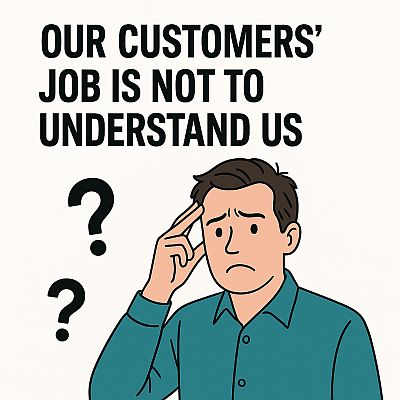We spend a lot of our time trying to make our customers understand our products and what they do. We want them to understand how our products solve their problems. We want them to see why our solutions are superior to what they are currently doing, or the alternatives they are considering.
The problem with this is that’s not their job! It’s not their job to understand us and what we do, it’s our job to understand them.
When we force our customers to understand us, most won’t take the time. They are consumed with doing their day jobs. They don’t have the time or reason to take the time to understand what we do.
And when they do, they don’t know what they should be looking for, what might be important and why. They may have made some faulty assumptions. They may have locked themselves into a definition of the problem that is incorrect or doesn’t fully capture what’s at stake. Or they may have been influenced by a competitor who takes the time to help them in the process.
We make the assumption they know how to go about solving the problem. We assume the customer knows how to navigate the problem solving/change process. And when we do this, we are immediately in a defensive position, perhaps trying to correct their misunderstanding, to shift their assumptions, to change their perspectives. The later we become involved in the process, the odds of us being able to shift their perspectives drop. The possibility of distinguishing our solutions diminish.
This is really about lost influence. Unwittingly, we are handing the role to help our customers over to our competitors. Or worse, we hand it over to no one–forcing the customer to figure it out themselves.
We know customers struggle. First, they struggle in recognizing the need to change. Then they struggle with identifying and defining the problem or change initiative. They don’t know who should be involved in the process, they don’t know how to assess the impact of the problem, understand the risk–both of not addressing the issues or the risks in changing. We know they wander through the process, stopping/starting, shifting directions, shifting priorities. We know most of the time, they abandon the effort, without ever reaching a conclusion and deciding to change.
Instead of forcing the customer to understand us and what we do; what if we flipped it? What if we focus on understanding them, what’s at stake for them, what it means, and why it is important?
In doing this, we would help them understand the need to change. They may be blind to this, they are so busy doing their day jobs, they don’t recognize things may have changed or there are new opportunities. They may be feeling the symptoms of the problem, but instead of trying to understand them, they double down on what they are currently doing. We can help them see what’s at risk or recognize there is an opportunity. We can leverage our experience in working with hundreds of others who have faced similar issues.
Once they recognize the need to change, we can help them define the problem, understand it’s potential impact, identify who needs to be involved, how to get management support. We can help them learn how others have managed the process. We can help them understand the data, interpreting what it means to them. We can help them navigate the process in a more disciplined way. Rather than wandering, starting/stopping, shifting directions, we can help them develop and execute a problem solving project plan that gets them to the desired outcome more quickly and successfully. And in doing this, we build their trust and confidence–not just with us, but that they are doing the right thing.
What happens when we do this? As you might expect, win rates skyrocket. No decision made is reduced by 20-25%. And buying cycles reduce by 30-40%! We’ve seen this with dozens of clients!
How do we shift what we do and how we engage our customers:
- Do your homework in understanding your customers deeply. What’s happening in their industry/markets? What’s happening with their company/organization? What are their key initiatives, what are the critical issues they and their customers face? How do we become as expert in their industry and challenges as they are?
- Lead with the problem, not what you sell. Imagine engaging your customers, never talking about your products, even if they ask you. Instead, make the conversation about them, the problem, what they are trying to achieve. Help them understand and define the problem, risks, and consequences.
- Help them navigate the process. Build the project plan with them, serve as their guide through the process. Help them reach the conclusion, making a decision in which they have confidence.
It’s not our customers’ jobs to understand us. It’s our job to understand them, helping them more effectively achieving their goals.
And through this, we achieve our shared goals.
Afterword: This is the AI generated discussion of this post. It’s longer than most of these discussions, but one of the best I’ve listened to. Enjoy!

Leave a Reply